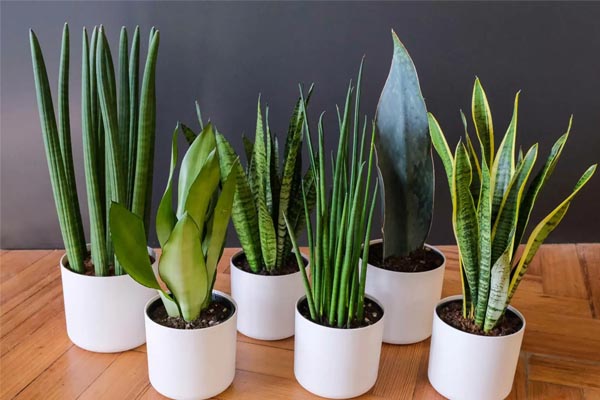
From Feng Shui to Oxygen Boost: The Multi-Faceted Benefits of Snake Plants
In indoor plants, the snake plant (Sansevieria trifasciata) is a versatile and beneficial addition to any home. From its aesthetically pleasing appearance to its air-purifying qualities, snake plants bring many advantages beyond mere decoration. In this blog, we’ll delve into the multi-faceted benefits of incorporating snake plants into your living space, touching on everything from the principles of Feng Shui to the science of oxygenation.
What is a snake plant?

The snake plant, scientifically known as Sansevieria trifasciata, is a frequently chosen houseplant from Asia and Africa. Characterized by its evergreen, upright, sword-shaped leaves, the snake plant resembles artificial foliage, making it a distinctive and visually appealing choice for indoor decoration.
Known for its aesthetic appeal, the snake plant is a popular addition to home decor. Its pleasing appearance, ease of care, and minimal water requirements make it a favoured choice among plant enthusiasts and those with varying levels of gardening experience. With its unique foliage and adaptability, the snake plant adds a natural elegance to indoor spaces, making it a go-to option for enhancing the visual appeal of homes and offices.
Also Read This : Easy and Budget-Friendly Herb Propagation from Cuttings
Multi-Faceted Benefits of Snake Plants

Feng Shui Harmony
Snake plants have long been celebrated in Feng Shui for bringing positive energy into a space. According to this ancient Chinese practice, snake plants promote good luck, prosperity, and overall well-being. Their upright and sword-shaped leaves are thought to create a sense of stability, making them an excellent choice for enhancing the energy flow in your home.
Also Read This : Growing 10 Ornamental Leafy Plants Successfully in Indoor Pots
Air-Purifying Prowess
One of the standout features of snake plants is their exceptional air-purifying capabilities. These plants are known for removing toxins such as formaldehyde, benzene, and xylene from the air, contributing to a healthier indoor environment. The NASA Clean Air Study identified snake plants as one of the most effective plants for improving indoor air quality, making them a practical choice for homes and offices.
Also Read This : Top 10 Herbs for Homegrown and Dried Culinary Delights
Low-Maintenance Marvels
For those with a busy lifestyle or a less-than-green thumb, snake plants are a dream come true. These hardy plants are incredibly low-maintenance, requiring minimal water and thriving in various light conditions. Their resilience makes them an ideal choice for beginners or those looking to add a touch of nature to their homes without the hassle of constant care.
Also Read This : Rapid Aloe Vera Growth: Essential Tips for Quick Thriving
Oxygen Boost
Beyond their air-purifying capabilities, snake plants play a crucial role in oxygenating indoor spaces. During the day, they undergo photosynthesis, converting carbon dioxide into oxygen and releasing it into the air. Placing snake plants in bedrooms or frequently occupied areas can improve air quality and create a more refreshing atmosphere.
Also Read This : Harvest to Home: A DIY Guide on Making Dry Herbs in Simple Steps
Aesthetic Appeal
Aside from their functional benefits, snake plants are visually appealing and can enhance the overall aesthetics of your home. With their striking architectural form and various cultivars offering unique patterns and colours, snake plants can complement multiple interior styles, from modern to traditional.
Also Read This : Plant These 8 Lucky Plants at Home in the New Year 2024
Caring for a snake plant

Caring for a snake plant is made easy by its low-maintenance nature, making it a popular choice for home decor. These resilient and hardy plants can thrive in various conditions, whether indoors or outdoors, and are well-suited to drier environments.
If you’re considering adding a snake plant to your home, here are some essential care tips:
Avoid Overwatering:
One of the critical considerations in snake plant care is to refrain from overwatering. These plants are susceptible to root rot if their soil is consistently too wet. Plant your snake plant in a well-drained pot to prevent water from accumulating, and only water the soil when it has completely dried out.
Also Read This : Biochar Brilliance: Enhancing Soil Health for Sustainable Agriculture
Optimal Sunlight Conditions:
Snake plants prefer indirect sunlight, making partial sun exposure ideal. While they can tolerate lower light conditions or brighter areas near windows, complete shade may lead to a loss of vibrancy in the plant, and the leaves might become limp.
Propagation Process:
Snake plants are easy to care for and simple to propagate. Follow these steps for successful propagation:
- Cut a healthy leaf near its base, creating an upside-down V cut at the bottom.
- Place the cut leaf in a clean jar of water, ensuring the water level is slightly above the V cut.
- Once roots have developed (usually within 3 to 5 weeks), you can either keep the plant in water or transfer it to soil.
By following these care guidelines, you can enjoy the beauty of snake plants in your living space while ensuring their longevity and vitality. The simplicity of their care routine and the ability to propagate quickly make snake plants an excellent choice for both seasoned and novice plant enthusiasts.
Also Read This : Tips For Curry Plant Growth: Secrets to Rapid Curry Plant Growth
Incorporating snake plants into your home goes far beyond mere decoration. From promoting positive energy with Feng Shui principles to purifying the air and boosting oxygen levels, these plants offer a holistic approach to enhancing your living space’s aesthetics and well-being. Whether you’re a plant enthusiast or a novice green thumb, consider bringing the multi-faceted benefits of snake plants into your home for a breath of fresh air and a touch of natural elegance.
Also Read This : Natural Garden Elixirs: 10 Surprising Fertilizers to Keep Your Garden Green




